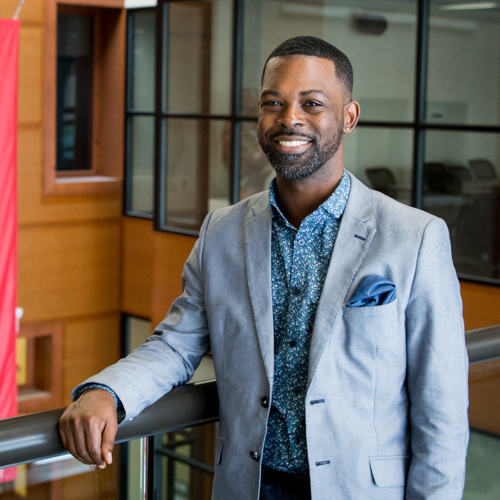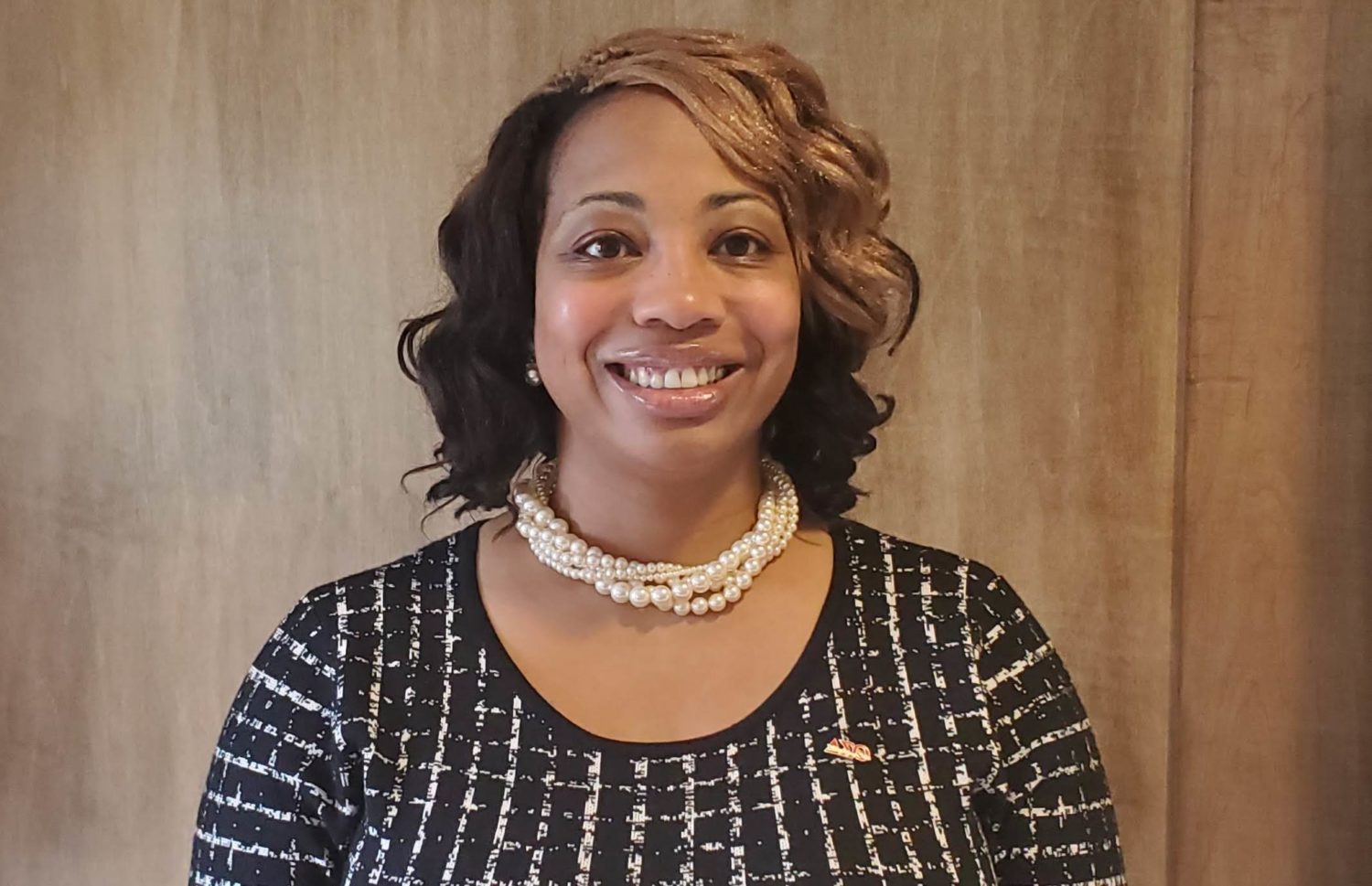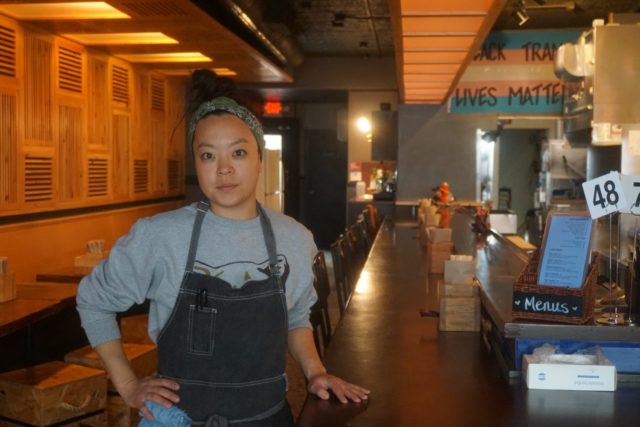We’re looking back at our favorite stories of 2022, including this one from our Lasting Impacts series on the pandemic’s lasting effects on the way we work.
 Sorrina Beecher had been entrepreneurial before.
Sorrina Beecher had been entrepreneurial before.
After working for a year at a daily newspaper in North Carolina, she got accepted to study journalism at Marquette University, near where she grew up. Like many journalism students, she applied to write for the school’s newspaper.
“My professor was like, ‘Why are you doing that? You did this already. Go be a freelancer,’” she recalls. And that’s exactly what she did, writing for many Milwaukee-area publications and eventually consulting on marketing, advertising and search engine optimization through college and young adulthood. By 2017, she was working full-time for a prestigious public relations firm in Milwaukee.
“I got promoted with a new title but not a raise,” she says. “I’m in my 30s and I was watching 22 and 23 year old girls get promoted to a higher status than me.”
With that subtle but growing discontent, she began thinking about going out on her own, but didn’t take the leap. Until the pandemic struck.

“In March (2020) we started working from home. In May I went to North Carolina. I talked to my parents and they’re like, ‘What’s holding you back from starting a business?’” she says. With support, encouragement and a small loan from her parents (“I didn’t even have my own laptop,” she recalls), she started The White Agency in September 2020 and hasn’t looked back.
While the entrepreneurial spirit was always there, it took a pandemic – and the resulting distance from the corporate world – to prompt her to take the leap.
“I just realized that there were these other opportunities out there. With the availability of remote … and with the availability of Zoom, all of these other productivity tools … it opened up my world of opportunity,” she says.
Working at home gave her the distance to reflect and the time to plan.
“I’m sure part of the impetus is that I realized, ‘Why aren’t I in a leadership position?’ I have all these people telling me that I’m a leader, but I wasn’t on committees,” she says. “I recognize that I come from a bit of privilege, but when I thought about my trajectory in the business world, I should be really a lot further ahead. And I started to question why that was. I started recognizing microaggressions – not that I think that they were intended, (but) I did start to kind of question that. My parents raised me to believe that I always had a seat at the table. And I started to question, why do I feel like people are trying to hold me down?”
She is quick to add that the agency she worked for was an excellent employer – but she wanted more than they could offer.
Now, a year and a half later, she says she’s tripled her income and is rapidly growing a nationwide clientele.
Meanwhile, in Madison, back in the spring of 2020, Francesca Hong was scrambling to make a different set of adjustments.
The co-owner of downtown restaurant Morris Ramen had to scramble to create a take-out menu, figure out how to make their signature high-end noodle dishes reheatable, and stock up on all the packaging and other supplies necessary to convert from a sit-town restaurant to take-out and delivery.
Even when restaurants began to reopen in 2021, things were different. People were on edge, often short-tempered. The pandemic had already taken an emotional toll on staff, and working the front lines had nerves frayed.
“I think in the hospitality industry where there is a lot of emotional labor that you can’t quantify … as much as I like to say that I was like a super-caring boss before, I think right now I’m even more aware that if I want there to be sustainability in the restaurant on many different levels and for us to do well, the wellbeing of our workers has to be prioritized,” says Hong, who also represents downtown Madison in the State Assembly. “When you’re in an industry where you’re having to serve others and (are) not always keenly aware of how you’re feeling yourself, or trying to mask how you’re feeling so that you can make sure you’re providing a positive experience for your customer, it is an immense amount of emotional labor that I think gets unnoticed. And so as an employer I’m more worried about the mental health of my staff.”

Beecher and Hong exemplify an undeniable fact: the pandemic has changed how, when and where we work – and fundamentally altered our relationship to our employers and how we think about work itself. Much has been said and written about “The Great Resignation” – 4.4 million Americans quit their jobs just last month, according to data released this week by the US Department of Labor. But there’s much more to it than that – much more to it than people deciding they don’t want to work, or demanding higher pay, or switching jobs for better perks.
Fundamental changes to both the workplace and the workforce have taken place in the past two years – and many experts say things will never be the same.
“I think it’s way more than a blip. And I think the sooner we sort of realize that and start to look at it from a longitudinal standpoint, I think we’re probably going to be better off. Every model that’s been built, you might as well scrap it,” says Mark Richardson, a Madison-based career and talent acquisition consultant. (Richardson was also previously on the board of directors of 365 Media Foundation, the nonprofit organization that publishes Madison365.)
“You can’t put that genie back in the bottle,” Richardson says. The genie he refers to is remote work – which has been possible in many sectors for years, but never the norm until the pandemic forced it.

“The ability to do your job, whatever that is, remotely from your home office, from elsewhere … that’s a wrap. That’s not going back,” he says. “You can say, hey, we want to come back to work, and we want you to come back to work. And here’s why: our culture, and team building, all that good stuff, you can want that, but you can’t say that the job has to be done from this location because now it’s been proven it doesn’t.”
“I think, in general, if you sat down with most young professionals, the general discussion would be, ‘I can do this whole thing from home. Why do I need to come in?’’ says Kurt Rose, Interim Human Resources Director at UW’s School of Education and president of the Urban League of Greater Madison Young Professionals.
That truth changes not only how we work, but how companies recruit, Richardson says.
“Talent doesn’t and won’t accept any longer that (they) have to move somewhere to work for a company,” he says. “We should be looking for talent in a new and different way… And we should also understand that we can hire remotely. And if we do hire remotely, we can hire and we can find talent of color in other cities and have them work for us here.”
Most employers won’t stick with a fully remote model – but multiple experts said a hybrid work model is here to stay.
“There’s a lot of advantages to both” working remotely and working in an office, says Angela Arrington, corporate counsel at Alliant Energy and a member of the utility company’s pandemic crisis response team. Alliant’s gradual return to a hybrid environment seeks to leverage the best of both worlds, she says: “There’s a lot of great things that have come out of the pandemic about how we work, where we work and when we work.”
“There’s pros and cons to everything,” Rose says. “I think (hybrid work) is a good thing. I do see advantages to interacting in person. I definitely see that. But I also see major advantages to providing flexibility to employees to be able to work from multiple (locations) in multiple capacities. I think the hybrid model could work really well, as long as everyone is on board.”
Arrington and Rose both noted the advantages of eliminating the commute – from a safety standpoint on those icy winter mornings, as well as the added productivity of being able to work through time once spent commuting.
Rose notes that even a gradual return to a hybrid work model should be undertaken cautiously.

“There’s a transition period of returning to even a hybrid capacity because of the effort and energy that’s required to just get there,” he says. “Not only is it the commute, but you also have your appearance and packing a lunch and if you have a family, transporting your children to where they need to be.”
Arrington says Alliant Energy places the premium on safety, wherever the work is happening.
“Safety drives what we do at Alliant. I really want to be clear about that,” she says. That means there hasn’t been an arbitrary timeline for a return to the office.
“It is about, number one, safety. Is it safe for us to even come back? That’s number one,” she says. “Number two was, in addition to the safety, if the answer is yes that it’s safe to go back, let’s do this in a way that is not a shock to people.”
She also says safety isn’t only about potential exposure to the novel coronavirus. All the old workplace safety issues are still there – even if your workplace is now at home. Legally, your employer is still largely responsible for your safety when you’re working, no matter where that is.
“Employers still have a responsibility for safety to you, even when you’re not in their physical space,” she says. “We worked with people that needed ergonomic setups. They needed to maybe have a certain kind of keyboard. They might have needed to have some kind of apparatus that they could put their laptop on because maybe the table that they’re using at home is too low. So we did all of those and we’re still doing those.”
Arrington also says bringing people back to the office requires considering more than logistics.

“There’s a lot of talk these days around culture in a company,” she says. “And it’s been interesting because we’ve had to rethink culture. We’ve had to rethink, what does that look like? Is culture everybody in the room together? Or can culture include the people that are also on the virtual platform and what they offer from where they are?”
The sudden advent of connecting via remote video – though the technology wasn’t new, the ubiquity of it was – also helped people find jobs and start businesses. Baltazar de Anda Santana, executive director of the Latino Academy of Workforce Development, said his organization placed 67 people in jobs in 2020, and 77 in 2021 – up from 25 in a normal year – at least in part because it offered classes and other services in a virtual format.
“We have folks who were looking for a job, and they got to know Latino Academy because we were doing classes virtually. So many other folks got to know the work that Latino Academy was doing. They were the ones that then benefited from getting employment,” he says.
Folks with an entrepreneurial streak also found it easy and affordable to take courses and find clients nationwide through virtual platforms.
“There were a lot of things that weren’t available (pre-pandemic), or that were more expensive to attain, because there were no virtual options,” Rose says. “So I might have to go all the way to LA to do this particular thing, where I might have to go all the way to New York to do this particular thing. And that was a barrier for individuals, especially for professionals who were looking for professional development. During the pandemic, so many things were offered in a virtual capacity, which made them a little bit more reasonable and more attainable.”
Some, like Sorrina Beecher, used the pandemic as a time to reassess what they wanted out of work, and to start new businesses.
“What changed with a pandemic is a lot of people reflected on their lives and you know what, we’re not immortal. We all have a limited time on this earth,” Beecher says. “Am I really happy where I am now?”
“I have seen the entrepreneurial spirit really spark at this time,” Rose says. “I think a lot of people took the time to either develop new crafts, or to sharpen their own skills during the pandemic. I’m seeing entrepreneurs really just flourish, or at least come out of the pandemic with a new plan.”
Others became entrepreneurs out of nothing but necessity – especially undocumented workers.
“While many businesses in 2020 were closing, there were many Latino-led businesses that were opening because they didn’t have any other choice,” de Anda Santana says. “Many of these folks were not eligible to get unemployment, were not eligible to get checks from the government. So they started opening their own businesses. We have many of our students who got laid off from working at restaurants, and what they did is that they started their own catering business.”
He says 83 of the Latino Academy’s students took the pandemic as an opportunity to earn their ServSafe certification from National Food Safety Training Institute, an important step in opening a food service business.
Still others who didn’t necessarily start businesses nevertheless took the pause to improve their prospects.
“I think those who did not have a job took advantage of the time that they have to be able to come to class, to be able to learn English, to be able to learn skills,” de Anda Santana says.

“I think the pandemic helped us realize that workforce development means human development,” de Anda Santana says. “We are working with human beings. We’re not working with machines. We always (say), “Workforce development. Workforce development.” That’s just human development. How we are developing these human beings so that they can have the tools for them to be able to work.”
Prioritizing mental health of employees is another common theme that emerged among employers and experts.
“I think it’s even more than before, and as much as I try to avoid saying, ‘now more than ever,’ the one thing that is at the forefront is being keenly aware and checking in on people’s mental health,” Hong says.
Arrington, of Alliant Energy, says psychological wellbeing is a workplace safety issue.
“I think that there was that element before in the workforce as a collective, but then the pandemic made you confront that you have no choice but to care about the physical and mental wellbeing of your employees, especially the psychological wellbeing,” Arrington says. “And for the record, for Alliant, we were doing that. But even we had to dig deeper. There was a much deeper dive.”
Further, employees placing their own mental health and well-being as a higher priority has led to a greater focus than ever on so-called “work-life balance.”
“I am proud that people are getting to a place where they are intentional about …work-life balance. And it matters that employers are, in my opinion, being very intentional,” Arrington says.
Employers have to be intentional, Richardson says, if they hope to retain talent.
“Employees’ work-life balance means a lot more to them than it did two years ago. And thus they’re not willing to work themselves into the ground,” he says. “I think one thing that’s gone probably unnoticed or not talked about enough is the organization or the company’s capacity not just to do this work, but to do anything. I’m seeing examples across different sectors of organizations struggling to return to doing the level and the quantity of work they were doing. And in some ways the quality of work they were doing. A company or an organization is made up of people. It may be singular in its name and its brand, but it’s made up of people and people’s ability to snap back to where they were in 2019 is proving to be far more difficult than anybody thought it would be. Imagine an employee coming back to a workplace after two years and expecting to be able to perform at that level that they were at. It’s almost unreal to expect they would.”
Hong says she’s seen the same trend in her restaurant.
“I think there’s way less of a desire to cover a shift. It’s easier to kind of just be like, ‘I can’t do this today.’ And for restaurants, as much as we’d like to give people all the time off that they need, we don’t have the staff,” she says. “There’s absolutely a capacity issue and a fatigue of having to constantly make it work with so little.”
A greater focus on equity in the workplace is another common thread among the changes in workplace culture, largely because the beginning of the pandemic was indelibly linked to the murder of George Floyd by a police officer.
“They’re always going to be linked because of COVID and the upheaval and the disruption and the fact that everyone was home, trying to figure out what life is going to look like, when this went down,” Richardson says. “The whole world was watching in a way that has never happened before. … All of the excuses to not get involved (in racial equity) as an employer went away that day and on the backside of that, now people are thinking, okay, how do we get involved? Not do we (get involved), how do we (get involved).”
He says more companies, organizations and government agencies were already looking to hire diversity, equity and inclusion managers, but that’s ramped up considerably.
“Employers are adding ( a DEI management) position to headcount in a way that I have not seen in years past and at a rate that I have not seen,” he says. “We’ve created safe spaces where the discussion and the journey can start and it doesn’t make for shorter conversations … it doesn’t make for easier conversations, but it makes for better ones. And when you start having better conversations around these issues, that’s when the culture starts to evolve.”
It’s also true, he says, that the pandemic and all of its many effects hit communities of color harder: “When you’re living towards the margins and there’s upheaval, your ability to stay on that razor’s edge becomes even tougher.”
Those factors have led, in some cases, to workers of color advocating for themselves more forcefully.
“Right now we, as a workforce, have woken up, and we have said, ‘No, I need to be in a place where I am respected. I need to be in a place that shares my same values, not just give me money. A place that respects me as an immigrant,’” de Anda Santana of the Latino Academy says. “That puts a higher expectation on the employer.”
And that work has to be authentic.
De Anda Santana says it’s not hard to tell when companies engage in diversity work to “check a box.”
Arrington agrees.
“I will say that people, especially when you’re talking about communities of color, are very keen, very intuitive, on when is this truly authentic? Is this just a talking point?” she says. “Because if you come to a company and you look around and you see very few people of color in particular, and then for the ones that are there, their average stay time is a year, two years. That’s a red flag.”
Arrington says in some cases, remote work actually helped with that authenticity, as some folks felt more comfortable expressing their views from the safety of their homes through a virtual meeting rather than in a conference room.
“So that leads into a bigger conversation about the honesty and the vulnerability that people are able to have in the virtual, or in a remote space. That is something that really needs to be unpacked, and that’s going to take courage for companies to go there because they may not like the answers. Because you could be the one asking the questions, and someone’s sitting there saying you’re the problem,” she says.
Related: people want to work with employers who share their values, and now more than ever feel empowered to say so.
“If you’re interviewing the younger generation now, they’re asking you about flexibility. They’re asking you about equity. And they’re asking you about where you stand as a company on social issues,” Richardson says. “Millennials and every generation since look longer and harder at the mission and the culture of a place than they do at the job description and the position requirements.”
A desire to do more meaningful work – or at least work for a company that shares your values – is a driving force behind that “great resignation,” Richardson says, though that manifests differently for different people.
“That’s already been happening and COVID fueled the fire for those who already were thinking like that, and it started people thinking like that who weren’t before,” he says. “That’s why this great resignation isn’t one thing, it’s a lot of things. If you’re 50-plus, it’s one thing because maybe you are now sliding into, ‘I want to (work at) a nonprofit for the last chapter of my career.’ If you’re 60-plus you took your retirement and said, ‘you know what? I’m not coming back to this craziness. I don’t have to do this.’ And if you’re 30 to 40, now it’s about mission-driven areas and companies and organizations versus those just making widgets and making somebody else money. It’s a lot of things.”
“I think employers now have to take into account being transparent about their employment practices and intentionality in diversifying their staff and providing opportunities,” Hong says. “I think an age where information can be so widely shared and individual employees are empowered to share stories of injustice in the workplace and bring these stories to light gives the people an opportunity to hold employers accountable. At a local small business level, I think there’s a lot more conversation. I’ve had conversations with some companies that are like, ‘We’re not overly political and we’re not going to make those social media posts. We don’t think our sales are going to be driven by that.’ But I push back on that a little bit, because they’re missing out on opportunities to engage in a creative and untapped workforce. I think there’s going to be a lot more mission and values-based employer practices that I hope will continue and they’re incentivized to do so.”
Of course, the ability to push back and hold employers accountable takes a certain amount of privilege.
“Not everyone in our community has the opportunity to demand jobs that meet their values, especially folks whose immigration status is different,” de Anda Santana says. “Those folks in our community … continue being our essential workers. That part of our community, our undocumented community, that because of where they are, they don’t have the opportunity to be selective. Obviously, that’s a huge issue because many of those folks are the ones who continue being the essential workers so that you and I can be working from home or from the office.”
He says a path to citizenship for undocumented workers would go a long way toward improving working conditions.
“For me, for 16 years, I worked under the shadow. I was able to co-found the Latino Academy of Workforce Development. Now, as a citizen, obviously, I have more opportunities. So if we give that to all those folks who are working under the shadow, our economy … will not have the issues that we have right now,” he says.
So what now?
“Don’t make three to five-year plans anymore. Make one to two-year plans,” Richardson counsels businesses. “Particularly as it relates to capital spending on space, on workforce. I don’t think you can plan five years out anymore.”
He also says it’s key to engage employees and listen – authentically.
“Put some stock in employee engagement. They’ll tell you what they think, he says. “And they’ll indicate what they think and what they will do and what they really want. It’s one thing to survey your employees annually, it’s a whole other thing to be prepared to react to what you hear … and the younger the employee is the more candid the conversation will be, for better or for worse. They know they can bounce if they want to. And they know you’re going to be in trouble if they do. They’re not holding the older generations hostage, but they are being clear about what they expect in a work culture.”
There’s no excuse not to embrace change, he says.
“I’m an optimist. I don’t know if I should be or not but certainly I’m a realist with optimist tendencies,” he quips. “What’s the reason why most systems and entities and enterprises don’t change? The reason is typically because we don’t want to stop everything we’re doing to make change. It would require that we disrupt everything to make significant change. Well, the disruption has already happened. The primary reason not to change has already been removed. The optimist in me wants us to look at COVID as a disruptor and to realize that we have a way we can make change and we can (improve on) how we went into the thing coming out of it.”
Richardson anticipates the post-pandemic era will be comparable to the post-World-War-II era in terms of the cultural shifts from before to after.
“I don’t even think we’ve seen or understand, really, the impact and won’t for years to come, but early indicators are people are they now are deciding, ‘okay, what does work look like for me? And where am I going to spend this time?’” he says. And they’re making really different decisions than any of the models (would predict). Nothing prepared employers … It’s fundamentally changed behaviors, and that was hard to read.”
Meanwhile, immigrant communities, and communities of color more broadly – even with a greater emphasis on racial equity – continue to face barriers.
This is especially true for those workers that the society deemed “essential” – service workers, factory workers, who tend to be more Black and brown.
“For many people, the pandemic shift them 100% so they are not ready to just iron their shirt and say, ‘Now, I’m going to go back to my little office,’” de Anda Santana says. “No, now, our community has to deal with still the drama of the pandemic, and still childcare, and still transportation, and some of those issues, trying to support their family, and at the same time, trying to have a job. It’s not that people don’t want to work. It is that the pandemic has put another set of barriers to our folks for them to be able to work. The pandemic has brought many, many obstacles to people of color. And if we were behind, now we’re really behind. It’s going to take a long time for us to get back to where we were before. We just have to keep pushing, and we have a community. Our folks of color, we are resilient, and we are creative. We’ll continue pushing.”
Lasting Impacts is funded by a grant from the Wisconsin Department of Health Services.




























